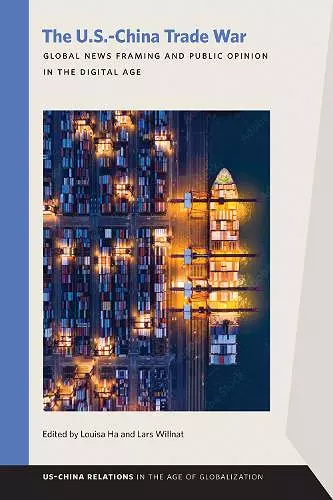The U.S.–China Trade War
Global News Framing and Public Opinion in the Digital Age
Louisa Ha author Lars Willnat author Louisa Ha editor Lars Willnat editor
Format:Paperback
Publisher:Michigan State University Press
Published:1st Apr '22
Should be back in stock very soon

Drawing on data from three national surveys, three content analyses, computational topic modeling, and rhetorical analysis, The U.S.–China Trade War sheds light on the twenty-first century’s most high-profile contest over global trade to date. Through diverse empirical studies, the contributors examine the effects of news framing and agenda-setting during the trade war in the Chinese and U.S. news media. Looking at the coverage of Chinese investment in the United States, the use of peace and war journalism frames, and the way media have portrayed the trade war to domestic audiences, the studies explore how media coverage of the trade war has affected public opinion in both countries, as well as how social media has interacted with traditional media in creating news. The authors also analyze the roles of traditional news media and social media in international relations and offer insights into the interactions between professional journalism and user-generated content—interactions that increasingly affect the creation and impact of global news. At a time when social media are being blamed for spreading misinformation and rumors, this book illustrates how professional and user-generated media can reduce international conflicts, foster mutual understanding, and transcend nationalism and ethnocentrism.
Ha and Willnat have achieved a major advance in the comparative study of news media coverage in application to an issue of great topical significance and concern in international relations. Embedded in agenda-setting and framing theory, the volume empirically and comprehensively analyzes the impacts of media structure, professional and user-generated journalism practice, and audience behaviors, as these range across legacy and digital media and through frames of war and peace. It identifies prevailing media narratives of threat and survival as worrying indications of potential future conflict.—Oliver Boyd-Barrett, professor emeritus, College of Arts and Sciences, Bowling Green State University, and coeditor, Media Imperialism: Continuity and Change
Solid, comprehensive, and comparative in perspective, this collection of empirical studies makes a timely and important contribution to our understanding of news framing and public opinion on a global issue across media systems in a digitizing world.—Joseph M. Chan, emeritus professor of Journalism and Communication, School of Journalism and Communication, Chinese University of Hong Kong
This book is insightful, analytic, and rigorous. Ha and Willnat and their constellation of communication scholars dissected the U.S.–China trade war and exhaustively examined how the trade war was framed by traditional and social media and Chinese and U.S. media, as well as partisan and government media. This book serves as an exemplar for future book authors wishing to study an international event; how public opinions are formed around it; and its many political, cultural, and economic implications.—Shuhua Zhou, professor and Leonard H. Goldenson Endowed Chair in Radio and Television Journalism, Missouri School of Journalism, University of Missouri
ISBN: 9781611864212
Dimensions: unknown
Weight: unknown
280 pages